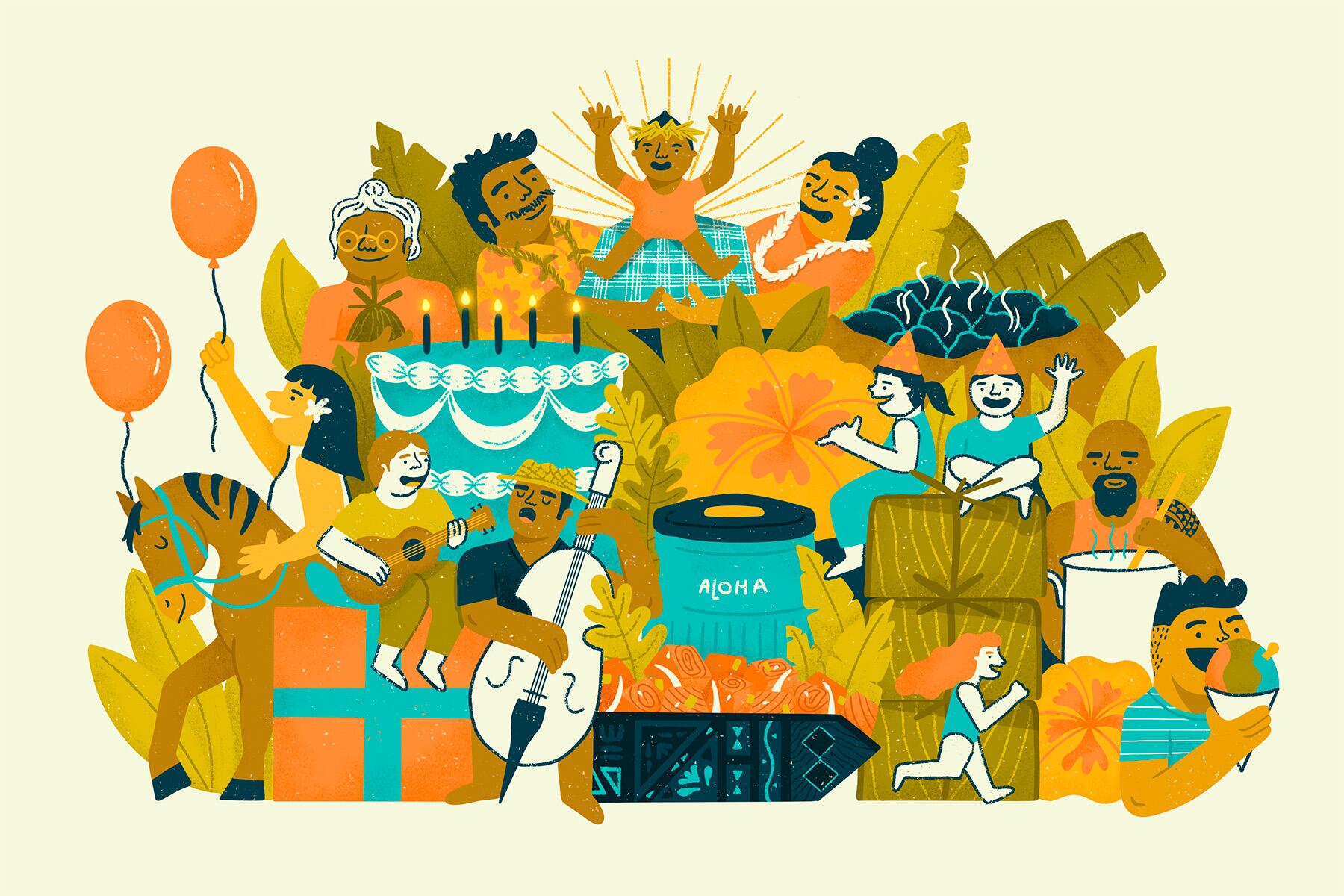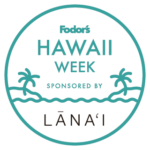In Hawaii, first birthdays get a lot more than cake and a "Happy Birthday" song.
O
ver the years, Native Hawaiians have remained committed to centuries-old traditions and customs like the ahaʻaina piha makahiki, now commonly known as the baby lūʻau. “Piha” is the completion of time. It marks the piha of the makahiki—so the completion of one year.
The term “ahaʻaina” was used for what we now call lūʻau until around the 1850s-1860s; after which we would see a combination of the two terms ahaʻaina-lūʻau and then simply lūʻau. In recent years, lūʻau has replaced the term ahaʻaina. Aha means the assembly or gathering, and aina represents the meal. For some Native Hawaiian speakers, the word lūʻau is said to be a more casual (or even crude) term as it is often haphazardly misused to describe “Hawaiian-themed” parties and exoticize Hawaiian culture.
Nevertheless, it has become the more common or mainstream term over the years due to tourism, cultural appropriation, and colonization. When referring to a lūʻau specifically, we must be mindful that it represents a method of food preparation in which edible taro leaves are wrapped around food before being placed in an imu (earth oven).
“Today, the baby lū‘au continues to be a time-honored tradition for Hawaiian residents in general (Kamaʻāina), not just for Native Hawaiians (Kānakaʻōiwi or Kānaka Maoli),” remarks Kainoa Daines, the Senior Brand Director at the Hawaii Visitors and Convention Bureau (HVCB).
But before that, Kānaka Maoli used celebrations for every important event. “If I had a new family,” explains Lalepa Koga, a Kamaʻāina professor of Hawaiian Language at The University of Hawaii at Mānoa, “I’d build my house. After I’d finished the house, I’d mark that event with an ahaʻaina.”
Recommended Fodor’s Video
He gives another example, “If I carved and finished my first canoe, I’d have an ahaʻaina. When you have a new child in the family, it’s a communal celebration because you have one more person in the family. You have another contributing member to that community, and who will also bring fortune to that community.”
So where did the idea of the lūʻau start? According to Koga, “The Hawaiian land system was such that a district of land incorporated related families from the ruling class; the general populace would be related as well.”
“Anytime they feasted, there was a communion of the families which helped to reinforce alliances for the ruling class. It also helped to reinforce the relationships between the fishermen and the farmer’s families,” continues Koga.
“Before the child was born, they’d have an ahaʻaina, but it was different from the one when the child lives their first year. It was another accomplishment—and that’s another thing about [Native] Hawaiian culture that many people forget. Accomplishments get marked,” Koga notes. “Tattooing represents an accomplishment. Accomplishments, or achievements, are marked by an ahaʻaina.” In essence, the community or familial bond is strengthened with each ahaʻaina.
According to Daines, “The first birthday was momentous due to high infant mortality rates in the pre-contact past.” He goes on, “Once a child hit their one-year milestone, their rate of a safe and healthy future increased dramatically, so it was a time to celebrate.”
Gisele Bisch, of Native Hawaiian, East Asian, and European ancestry, turned to her mother and grandmother to share their perspective regarding the baby lu’au origins. “It has been so ingrained in my family for decades—my sister and I each had one, too,” reminisces Bisch, originally from the North Shore of Oahu, Hawaii, and studying Anthropology at Princeton University. “According to them,” she continues, “in older times, the infant mortality rate was really high in Hawaii. So, people in Hawaii (Native Hawaiians and non-Natives) began to celebrate the first year of life, since the first twelve months were the most critical time for the baby.”
“The First Birthday celebration is very important with every culture in Hawaii because it’s a tradition and a cause for celebration because it’s the first milestone the child goes through in their life,” explains proud parent Roland Aggabao, a Filipino-Hawaiian who is husband to Kānaka Maoli woman. “The baby’s first birthday is also a milestone for the parents of the child too, because of all the work, sleepless nights, sacrifices, and stress they went through caring for their baby during their first year,” he continues. “It’s a cause of celebration for them, too—for getting through caring for their baby during their first year of life.”
“To my understanding,” elucidates Bisch, “that’s how it’s become such a widespread tradition for families living in Hawaii. Nowadays, however, these first birthday celebrations are more commonly celebrated as regular pāʻina (parties), rather than traditional lūʻau.”
The local populace now encompasses a range of ethnicities, including Polynesian, Micronesian, Melanesian, and those with origins in Asia, Africa, the Caribbean, Europe, and the Americas. Still, the emergence of what is considered a “melting pot” is rooted in colonization and imperialism.
Not unlike Native and Indigenous Peoples on the American continents and beyond, the Kānaka Maoli have long suffered from a significant disruption of culture. This includes war, the introduction of diseases brought by Europeans and Asians to Hawaii, a drastic decline in population, and systematic racism that the Kānaka Maoli still face to this day. And throughout it all, deep ties to their ethnic roots—namely, the language, traditions, preservation of historic relics, lands, and stories—keep the Aloha spirit alive.
“A lot of people try to make their baby lū‘au Hawaiian. And even though it may be within a Filipino or a Samoan community, they always give a nod to the Hawaiian roots,” acknowledges Koga. But one thing is for certain, no matter the origin of the family, the celebrants understand the importance of being connected to the beautiful and diverse land.
But how much planning goes into a typical event? “The preparation of the feast is a community effort, even today—all the family and all the friends come together. They pool their resources to celebrate the new addition to the community,” reveals Koga.
“The whole extended ʻohana of the baby usually gets invited. The size varies depending on the family, but usually, baby lūʻaus have hundreds of family members and friends attending the celebration,” says Aggabao.
The scale of the first birthday celebration is comparable to a small wedding. “The largest party I have worked at had about 150 people,” exclaims Keilani Milling, who identifies as Kamaʻāina and is the Owner and Head Painter of Island Girl Face Art. “I have worked smaller events in the swanky executive suites of all the major resorts and super laid-back huge events on the beach,” Milling shares.
While some families opt for quaint celebrations in the comfort of their own homes, other parties can be more ostentatious. Nevertheless, all will include an appreciable amount of food. The typical menu for a feast is nothing short of tantalizing—and it’s best to tackle it with an empty stomach. The staples include fish (typically white fish), poi (taro), kālua puaʻa (Kalua pork), and chicken. The excitement doesn’t stop with the food. On any scale, you’ll find an array of entertainment from face painting, live-action pop culture characters, out-of-this-world themes, photo booths, treasure hunts, and even live bands.
“As we specialize in character entertainment, the Happy Birthday segment is key to closing out the party and making each event a memorable experience,” details Casey Fortuna, a non-Native Hawaiian local and Owner of Storybook Entertainment and Storybook Station enthusiastically serving both Kānaka Maoli and Hawaiians of diverse backgrounds. She continues, “Usually, it is followed by a slideshow of the baby’s first year of life. We gather the guests and lead them in a special honorary ceremony before singing ‘Happy Birthday.'”
When asked what advice he’d give to a first-time guest, Aggabao offers this gem, “If you’re free, volunteer to help with the baby lūʻaus, especially if they’re wrapping laulau or cooking meat in an imu. There is nothing like that experience, and you will truly feel what the Aloha spirit really is.”
Hawaii is more than a place for adventure. The land and people share a deep connection that you can only begin to understand by learning from those who preserve and honor Native culture, traditions, and stories. If you’re fortunate to be invited to an ahaʻaina piha makahiki or baby lūʻau, remember that the aim is to join the Kānaka Maoli in remembrance of a time when infant mortality was at an unprecedented high and in celebration of their resilience and good fortune in adding a precious new member to the community.
Editor’s Note: Per the Hawaii Tourism Authority, Fodor’s recognizes “the proper use of the Hawaiian language, ‘Ōlelo Hawai‘i,’ which includes the ‘okina [‘], a consonant, and the kahakō [ō] or macron.” The Hawai‘i Board on Geographic Names was created to “assure uniformity and standardize spelling of geographic names to communicate unambiguously about places, reducing the potential for confusion.” In order to ensure our readers the best experience reading our Hawaii travel guides, we follow the standardized spelling, but hope to expose readers to the importance and cultural significance of the written Ōlelo Hawai‘i language.




